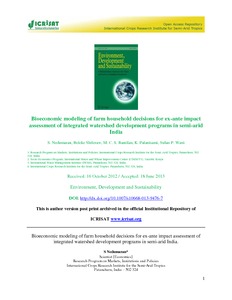Bioeconomic modeling of farm household decisions for ex-ante impact assessment of integrated watershed development programs in semi-arid India
Abstract
The increasing population and urbanization have serious implications for sustainable development in less-favoured areas of developing countries. In an attempt to sustain the long-term productivity of natural resources and to meet the food and non-food demands of growing population in the semi-arid tropics, the Indian government invests and promotes integrated watershed development programs. A comprehensive tool to assess the impacts of watershed development programs on both social well-being and sustainability of natural resource is currently lacking. In this study, we develop a watershed level bioeconomic model to assess the ex-ante impacts of key technological and policy interventions on the socioeconomic well-being of rural households and the natural resource base. These interventions are simulated using data from a watershed community in the semi-arid tropics of India. The model captures the interaction between economic decisions and biophysical processes and using a constrained optimization of household decision model. The interventions assessed are productivity-enhancing technologies of dryland crops and increased in irrigable area through water conservation technologies. The results show that productivity-enhancing technologies of dryland crops increase household incomes and also provided incentives for conserving soil moisture and fertility. The increase in irrigable area enables cultivation of high-value crops which increase the household income but also lead to an increase in soil erosion and nutrient mining. The results clearly indicate the necessity for prioritizing and sequencing technologies based on potential effects and trade-offs on household income and conservation of natural resources

